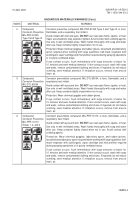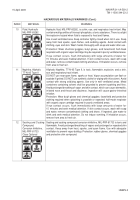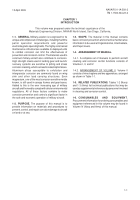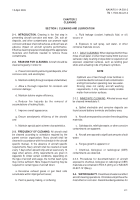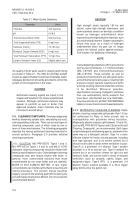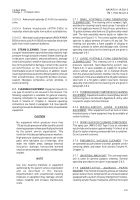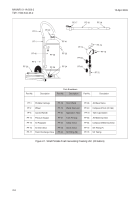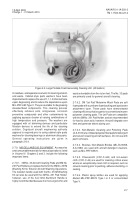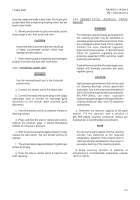TM-1-1500-344-23-2 - Page 26 of 240
2-2
NAVAIR 01-1A-509-2
TM 1-1500-344-23-2
15 April 2009
the quality of fresh water used for cleaning and rinsing
are shown in Table 2-1. The limits for chlorides and pH
shown are approximately the same as for potable water.
Adequate disinfection should be provided to control the
growth of microorganisms in the water.
CAUTION
Authorized cleaning agents are listed in this
chapter and Volume IV. Do not use unauthorized
cleaners. Although commercial cleaners may
appear to perform as well or better than
approved products, these materials may be
corrosive to aircraft alloys.
2-5.
CLEANING COMPOUNDS.
Cleaning compounds
work by dissolving soluble soils, emulsifying oily soils,
and suspending solid soils. There are several types of
cleaning compounds, each of which clean by one or
more of these mechanisms. The following paragraphs
describe the various authorized cleaning materials for
aircraft surfaces. Paragraph 2-9 provides detailed
cleaning procedures.
2-5.1. DILUTION. MIL-PRF-85570 Types I and II,
MIL-PRF-85704 Types I, II and III, and MIL-D-16791
detergent cleaning compounds should be diluted with
water as specified prior to use. Other detergent cleaning
compounds may also require dilution with water. In
general, more concentrated solutions than those
recommended do not clean better and are wasteful;
MORE IS NOT ALWAYS BETTER. In fact, higher
concentrations can interfere with effective cleaning and
rinsing processes. The solution merely becomes
slippery, prevents the washing pad from loosening the
soil and makes rinsing more difficult. Do not exceed the
recommended dilution.
CAUTION
High strength steels (typically 180 ksi and
above), some high strength aluminums, and
some stainless steels can develop a condition
known as hydrogen embrittlement when
exposed to some highly alkaline materials, such
as unauthorized cleaners. Sudden catastrophic
failure may occur as a result of hydrogen
embrittlement when the part can no longer
sustain the internal and/or applied stresses.
See Volume I for additional information.
NOTE
Ozone depleting substances (ODS) are solvents
such as, but not limited to, 1,1,1 trichloroethane
(MIL-T-81533) and trichlorotrifluoroethane
(MIL-C-81302). These solvents, as well as
products containing them, are still used in some
aircraft maintenance processes, including high
pressure oxygen systems cleaning and some
avionics cleaning. Alternate materials continue
to be identified. Wherever possible,
specifications are being changed to eliminate
their use automatically. Some products that
have been reformulated are now flammable.
Pay close attention to all CAUTION/WARNING
labels on solvents and solvent-based products.
2-5.2. MODERATELY ALKALINE CLEANERS. Highly
alkaline cleaning compounds (pH greater than 10) are
not authorized for Navy or Army aircraft, due to
incompatibility with polyimide wiring insulation.
Moderately alkaline cleaners (pH between 7.5 and 10),
such as MIL-PRF-85570 Types I and II (Exterior Aircraft
Cleaning Compound), are recommended. Both types
contain detergents and foaming agents, and work in the
same way as a detergent solution. Type I is a more
effective cleaner for heavy oils and greases, including
wire rope lubricant, due to its solvent content, but it
should not be used in areas where ventilation is poor.
Type IA is a premixed (1:4 dilution) Type I solution
available in a 16 oz aerosol can. Type II contains no
solvent but is an excellent cleaner for light oils and
hydraulic fluids, and can be used in areas of reduced
ventilation (such as cockpits, cabins, bilges, and
equipment bays). Type II RTU
is a premixed (1:4
dilution) Type II solution available in a 32 oz trigger
spray bottle and a five gallon can.
r
e
t
e
m
a
r
a
P
s
t
i
m
i
L
s
e
d
i
r
o
l
h
Cx
a
m
l
/
g
m
0
0
4
H
p5
.
8
-
5
.
6
)
S
D
T
(
s
d
i
l
o
S
d
e
v
l
o
s
s
i
D
l
a
t
o
Tx
a
m
l
/
g
m
0
0
5
)
S
S
T
(
s
d
i
l
o
S
d
e
d
n
e
p
s
u
S
l
a
t
o
Tx
a
m
l
/
g
m
5
O
C
a
C
(
s
s
e
n
d
r
a
H
3
)l
/
g
m
0
5
1
-
5
7
)
D
O
B
(
d
n
a
m
e
D
n
e
g
y
x
O
l
a
c
i
g
o
l
o
i
Bx
a
m
l
/
g
m
5
)
H
P
T
(
n
o
b
r
a
c
o
r
d
y
H
m
u
e
l
o
r
t
e
P
l
a
t
o
Tx
a
m
l
/
g
m
0
1
)
I
S
L
(
x
e
d
n
I
n
o
i
t
a
r
u
t
a
S
r
e
i
l
g
n
a
Lo
r
e
z
e
v
o
b
a
y
l
t
h
g
i
l
S
Table 2-1. Water Quality Guidelines
Change 1 - 31 March 2010
Back to Top


